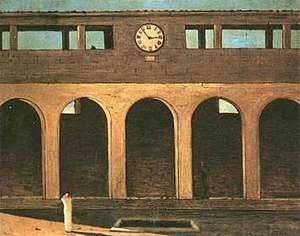The Enigma of the Hour
The Enigma of the Hour (1911) is a painting by the Italian metaphysical painter Giorgio de Chirico. He created the work during his early period, in Florence,[1] when he focused on metaphysical depictions of town squares and other urban environments.
| The Enigma of the Hour | |
|---|---|
 | |
| Artist | Giorgio de Chirico |
| Year | 1911 |
| Medium | Oil on canvas |
| Location | private collection |
The Enigma depicts an urban scene with the classical architecture and angular lighting that are de Chirico's hallmarks. Several figures around the scene have vague features, to give the sense that they are absent. Above the scene is a large clock that reads five minutes to three.[2] Luca Cottini referred to the clock as "...[suggesting] the paradox of an 'eternal present,' located on the edge of a-temporal revelation and moving temporality, and [enacting] the enigma of its nature."[2]
Peter G. Toohey has asserted the figure in white represents Odysseus.[3]
References
- Baldacci, Paolo (1 May 2017). "Giorgio de Chirico, The Enigma of the Hour (1910): The First Conceptual Work of Art". The Brooklyn Rail. Retrieved 1 July 2020.
- Cottini, Luca (2018). The Art of Objects: The Birth of Italian Industrial Culture, 1878-1928. University of Toronto Press. pp. 47–48. ISBN 9781487516116. Retrieved 1 July 2020.
- Toohey, Peter (2004). Melancholy, Love, and Time: Boundaries of the Self in Ancient Literature. University of Michigan Press. p. 289. ISBN 9780472113026. Retrieved 1 July 2020.